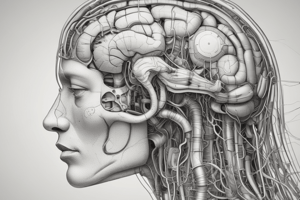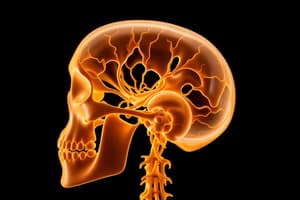Podcast
Questions and Answers
Which nuclei are part of the basal ganglia?
Which nuclei are part of the basal ganglia?
- Caudate, putamen, globus pallidus, subthalamic nucleus, substantia nigra (correct)
- Cerebellum, thalamus, inferior colliculus, vestibular nuclei
- Midbrain, cortex, red nucleus, substantia gelatinosum
- Hippocampus, amygdala, basal forebrain, dorsomedial nucleus
What effect does the direct pathway of the basal ganglia have on motor activity?
What effect does the direct pathway of the basal ganglia have on motor activity?
- It has no significant effect on motor activity.
- It increases the overall muscle tone which affects all movements.
- It facilitates movement by reducing inhibition on motor activity. (correct)
- It suppresses motor function by enhancing inhibitory signals.
What is a common symptom of Parkinson's disease?
What is a common symptom of Parkinson's disease?
- Excessive movement
- Sudden bursts of activity
- Tremors and stiffness (correct)
- Overactivity in the cerebellum
What is the primary function of the basal ganglia compared to the cerebellum?
What is the primary function of the basal ganglia compared to the cerebellum?
What type of disorder can result from lesions in the basal ganglia?
What type of disorder can result from lesions in the basal ganglia?
What role does the Upper Motor Neuron (UMN) play in the motor system?
What role does the Upper Motor Neuron (UMN) play in the motor system?
Which pathway in the motor system is primarily responsible for controlling fine, voluntary movements?
Which pathway in the motor system is primarily responsible for controlling fine, voluntary movements?
What is the main consequence of damage to Lower Motor Neurons (LMN)?
What is the main consequence of damage to Lower Motor Neurons (LMN)?
How does the motor system utilize negative feedback?
How does the motor system utilize negative feedback?
What is a characteristic of spasticity resulting from Upper Motor Neuron lesions?
What is a characteristic of spasticity resulting from Upper Motor Neuron lesions?
Which current understanding reflects the role of the cerebellum in movement?
Which current understanding reflects the role of the cerebellum in movement?
What is the role of the basal ganglia in the motor control loop?
What is the role of the basal ganglia in the motor control loop?
In the context of motor disorders, what do extrapyramidal disorders typically resemble?
In the context of motor disorders, what do extrapyramidal disorders typically resemble?
Which deep cerebellar nuclei are collectively referred to as the interpositus nucleus?
Which deep cerebellar nuclei are collectively referred to as the interpositus nucleus?
What type of input do climbing fibers provide to Purkinje cells?
What type of input do climbing fibers provide to Purkinje cells?
Which area of the cerebellum is primarily responsible for trunk control?
Which area of the cerebellum is primarily responsible for trunk control?
What is the main function of the deep cerebellar nuclei (DCN)?
What is the main function of the deep cerebellar nuclei (DCN)?
Which symptom is typically associated with dysfunction of the cerebellum?
Which symptom is typically associated with dysfunction of the cerebellum?
What role does the cerebellum play in motor learning?
What role does the cerebellum play in motor learning?
How do lesions in the cerebellum affect movement?
How do lesions in the cerebellum affect movement?
What happens to the posture of a person with cerebellar dysfunction?
What happens to the posture of a person with cerebellar dysfunction?
Flashcards
Motor System
Motor System
A system responsible for voluntary, complex movements, carefully timed and coordinated.
Extrapyramidal disorders
Extrapyramidal disorders
Movement disorders often linked to psychiatric conditions or medications.
Hierarchical Organization (Motor System)
Hierarchical Organization (Motor System)
Information flows through multiple control centers to coordinate movements.
Upper Motor Neuron (UMN)
Upper Motor Neuron (UMN)
Signup and view all the flashcards
Lower Motor Neuron (LMN)
Lower Motor Neuron (LMN)
Signup and view all the flashcards
UMN Lesions
UMN Lesions
Signup and view all the flashcards
LMN Lesions
LMN Lesions
Signup and view all the flashcards
Cerebellum's Role
Cerebellum's Role
Signup and view all the flashcards
Basal Ganglia Function
Basal Ganglia Function
Signup and view all the flashcards
Parkinson's Disease Cause
Parkinson's Disease Cause
Signup and view all the flashcards
Basal Ganglia Pathways
Basal Ganglia Pathways
Signup and view all the flashcards
Basal Ganglia vs. Cerebellum
Basal Ganglia vs. Cerebellum
Signup and view all the flashcards
Basal Ganglia Subcortical Nuclei
Basal Ganglia Subcortical Nuclei
Signup and view all the flashcards
Deep Cerebellar Nuclei
Deep Cerebellar Nuclei
Signup and view all the flashcards
Cerebellar Zones
Cerebellar Zones
Signup and view all the flashcards
Mossy Fibers
Mossy Fibers
Signup and view all the flashcards
Climbing Fibers
Climbing Fibers
Signup and view all the flashcards
Purkinje Cells
Purkinje Cells
Signup and view all the flashcards
Cerebellar Dysfunction
Cerebellar Dysfunction
Signup and view all the flashcards
Cerebellar Function
Cerebellar Function
Signup and view all the flashcards
Cerebellar Lesion Symptoms
Cerebellar Lesion Symptoms
Signup and view all the flashcards
Study Notes
The Motor System
- The motor system allows for voluntary, complex movements.
- Extrapyramidal disorders are common in people taking psychiatric medications.
- Information flows across multiple control centers, using negative and feed-forward mechanisms.
- Negative feedback adjusts movements by comparing intended and actual movements.
- Feed-forward utilizes memory to anticipate and adjust for rapid movements.
How the Motor System Works
- Motivation for movement originates in subcortical areas (limbic areas, hypothalamus, cerebellum, basal ganglia).
- Motor programs (intended movement sequences) are developed in premotor and supplementary motor areas and relayed to the primary motor cortex.
- Motor commands travel along two main pathways:
- Upper Motor Neuron (UMN): Initiates movement from the brain cortex.
- Lower Motor Neuron (LMN): Connects to muscles, enabling movement.
- UMN lesions cause spasticity, exaggerated reflexes, and a positive Babinski sign.
- LMN lesions result in flaccid paralysis, muscle atrophy, and loss of reflexes.
Major Pathways of Axons from the Brain
- A loop, or pathway, involving the cerebral cortex, basal ganglia, thalamus, and back to the cortex has components: one for direct facilitation and another indirect inhibition.
- Output from the Globus Pallidus Internal (GPi) and Substantia Nigra pars reticulata (SNr) is inhibitory to the thalamus.
- Lateral Pathways (Direct): Control fine, voluntary movements; direct pathway inherent / spontaneous GPi activity is ↓ by striatal activity, leading to disinhibition, and facilitating movements.
The Cerebellum
- Located in the back of the brain.
- Crucial for movement coordination by receiving sensory information and adjusting muscle actions.
- Its 4 deep nuclei (dentate, globose, emboliform, and fastigial, or interpositus) are largely responsible for output.
- Cerebellar organization has zones for control of midline, limbs, and digits.
- Input to the cerebellum occurs via mossy and climbing fibers.
- Mossy fibers originate from diverse sources (cortex, spinal cord, and brainstem) to stimulate granule cells, and have weak excitatory input to Purkinje cells.
- Climbing fibers originate in the inferior olivary nucleus, and provide strong excitatory input to Purkinje cells, leading to complex neural spikes.
- Purkinje cells output to deep cerebellar nuclei.
Deep Cerebellar Nuclei
- Signal: Inhibitory GABAergic output.
- Target: Various brain regions, including the thalamus, red nucleus, and vestibular nuclei.
- Signal: Excitatory output for modulating motor control and coordination.
- The cerebellum's role encompasses timing and coordination of movement, motor learning, and balance and posture maintenance. It acts as a fine-tuning mechanism for movement.
Basal Ganglia
- Five interconnected subcortical nuclei (caudate, putamen, globus pallidus, subthalamic nucleus, and substantia nigra).
- Crucial for initiating and regulating movement.
- Extensive connections between basal ganglia and motor areas of the brain.
- Primary input from the cerebral cortex, output via thalamus, back to the cortex.
- Direct pathway in facilitates movement by reducing inhibition.
- Indirect pathway suppresses unnecessary movement by increasing inhibition.
- Disorders can result in hyperkinetic (excessive movement) or hypokinetic (reduced movement) symptoms.
Differences Between Basal Ganglia and Cerebellum
- Basal Ganglia: Controls movement initiation and pattern selection
- Cerebellum: Refines and coordinates ongoing movement
- Basal ganglia involved in cognitive movement planning, while the cerebellum adjusts movements in real-time.
- Key Point : Basal gangliia are involved in cognitive planning of movement and the cerebellum adjusts real-time movements.
Studying That Suits You
Use AI to generate personalized quizzes and flashcards to suit your learning preferences.




